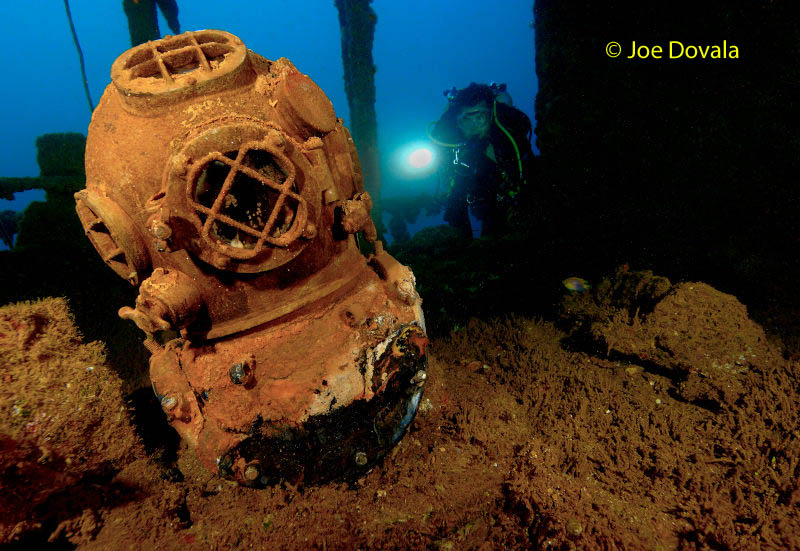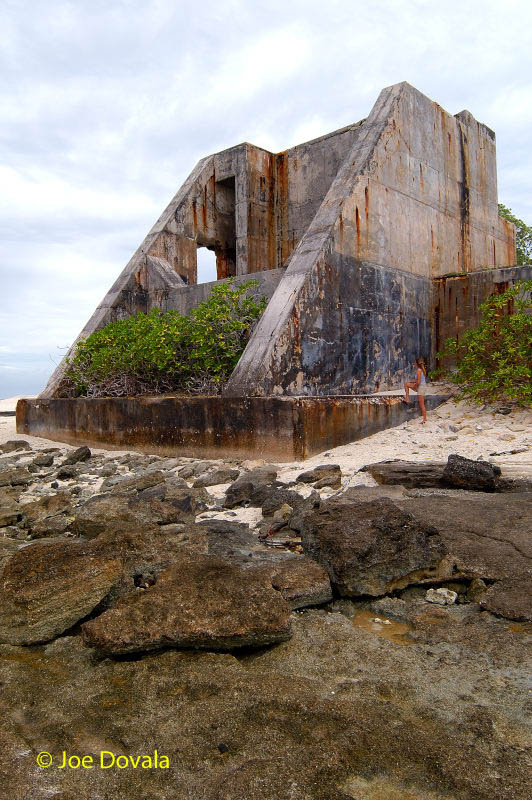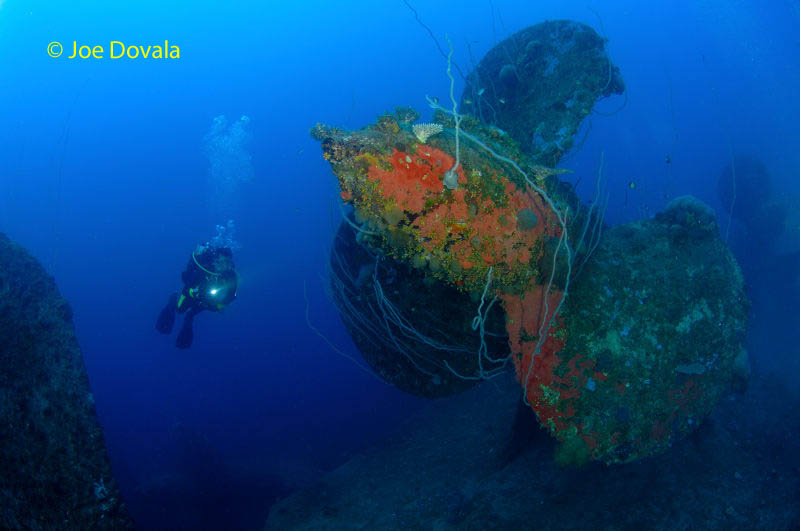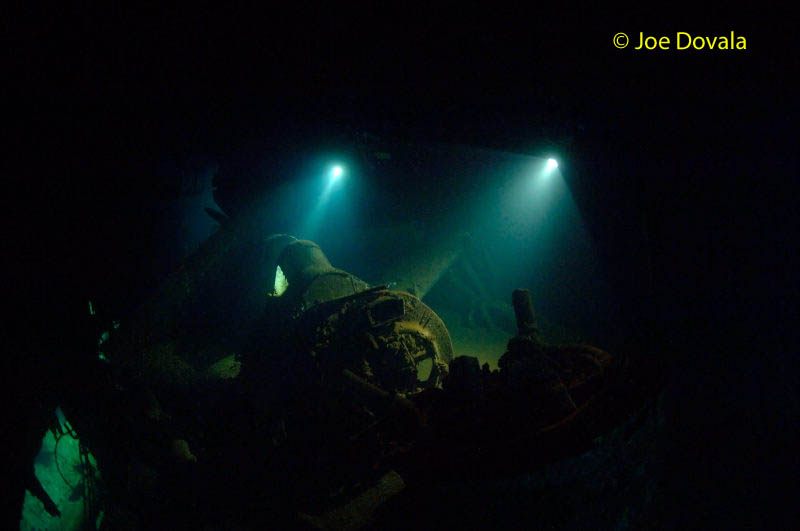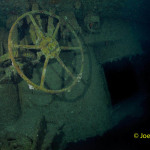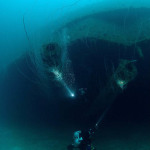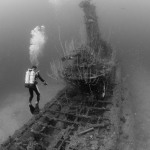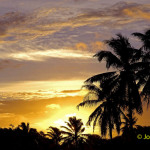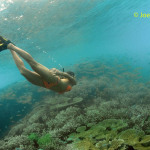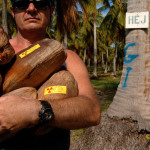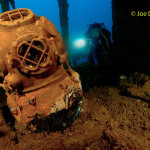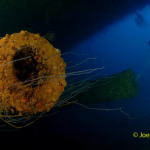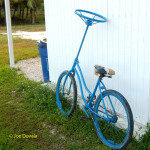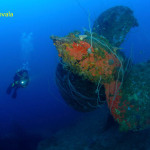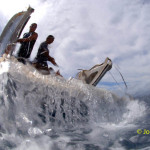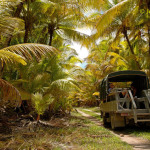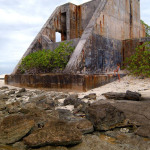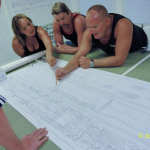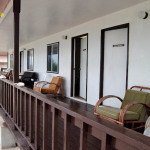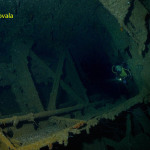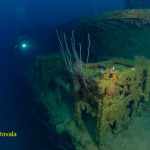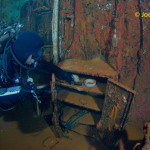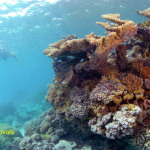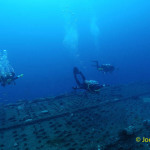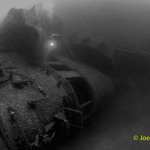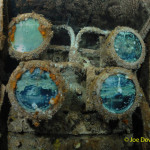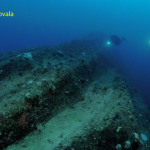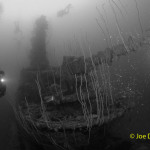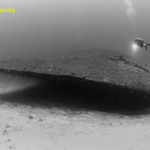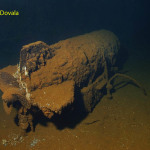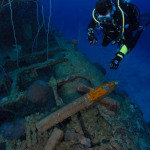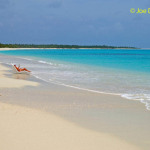Size does matter. It matters a lot. The gargantuan flight deck of the USS Saratoga materialized out of the blue and I found myself testing my regulator’s flow capacity at only 50 feet. I was privy to a mere fraction of the 880-foot long former floating airfield stretched out before me, yet I could vividly imagine bringing in my Hellcat from a successful sortie. Everywhere you looked nautical artifacts made their appearance; navigation equipment, admiral’s china, clocks, even a bugle adorned the vessel. Half-a-dozen reef sharks flew in formation over the massive deck as if circling to land. All this in the first twenty minutes of our check out dive – day one.
This was supposed to be a nice leisurely swim above the flight deck of the world’s only fully loaded diveble aircraft carrier. You know, the dive masters watch you get suited up, evaluate your watermanship skills, and then decide how to schedule the week’s dives. Nonetheless, trying to keep everyone focused on the “check out” proved tougher then herding cats. Geez, this wasn’t some run of the mill ship sanitized and all cut open for diver safety. She’s “Sara,” our country’s first fleet aircraft carrier and virtually all our pioneer naval aviators flew off her decks. She also took part in scores of WWII battles across the Pacific, earned eight battle stars and could not be destroyed by the Japanese, despite hits by Kamikazes and reported sunk multiple times. It took not one but TWO atomic bombs from our own Army/Navy to finally put her on the bottom. I haven’t felt this way on a dive since Cocos Island. We eventually made three more dives on Sara as well as visiting six other ships, barely scratching the surface of this sub-sea fleet. It’s not only the physical size of the nuked Bikini fleet that over whelms you but also the historical significance of these vessels that takes your breath away.
Bikini Atoll is one of 29 atolls scattered through out 750,000 square miles of blue Central Pacific Ocean that make up the Marshall Islands. More than a thousand small islands dot this immense area. Despite the number of islands, the total land area is only about 70 square miles with a mean elevation of some seven feet. Yes, they are very concerned about global warming.
As you might expect the waters are teaming with marine life. Nearly 200 hundred species of coral, well over 250 species of fish, all five species of marine turtles, and nearly 30 species of marine mammals make a home here. Much of the vast marine environment has yet to be systematically studied so additional species are likely to be found. On the tiny land mass live some 70 species of birds, seven species of lizards, and one native mammal – the Polynesian rat.
Words & Photos by Joe Dovala, Dovala Photography. Visit Joe’s website here.
It’s likely Micronesian sea farers sailed into the Marshall Islands between 2000 and 500 BC, though little is known about them. The Marshalls never unified under one top dog but certain chiefs did manage to control several atolls at a time. Like other rulers across the Pacific they had absolute control over their subjects and the land. In 1494, the Treaty of Tordesillas (a treaty which split the world up outside of Europe between Portugal and Spain) gave “ownership” of all Micronesia to Spain. The Marshall Islands were off the main trade routes so the Spanish didn’t even lay eyes on them until 1525. There was little interest in colonizing, so another 263 years passed until an English captain named John Marshall sailed by. The islands eventually took his name. During the early 1800’s many visits from whaling and trade ships stressed the relations between natives and the Europeans, and so these islands were considered hostile territory. When the first missionaries arrived in the 1850’s it was the beginning of the end for the traditional authority of the island chiefs.
In 1885, Germany appropriated the islands and controlled them until 1914 when the Japanese took over at the start of the First World War. After the war, the Japanese were given control of the islands courtesy of a mandate by the League of Nations. They heavily colonized and began fortifying military bases throughout the Pacific, with the exception of Bikini where they established a small weather station. During the Second World War, furious battles were fought all around Bikini with a particularly nasty engagement at Kwajalein in 1944. By the end of the war in mid 1945, the United States had a firm hold on the Pacific. And soon, the peaceful out-of-the-way atoll of Bikini was to become the focus of the entire world.
It was 1946, and despite the two atomic bombs recently dropped over the Japanese cities of Nagasaki and Hiroshima, much of the world (read Soviet Union) was unconvinced of the awesome destructive power of the new weapons in America’s arsenal – or even that they in fact existed. So the powers that be decided that a “little” show was in order and a virtually unknown atoll in the Marshall Islands became the lucky winner for ground zero. Now you have to remember that the world had just finished the most globally devastating war in history and the United States no longer was the isolationist country she’d been prior to 1941. As anyone who has seen the movie Patton knows, sabers were rattling between the US and Russia even before the first Nazis were signing their fraudulent Brazilian passports. So forty thousand U.S. military personnel and a fleet of some 240 ships descended on the lagoon and the lush island paradise of Bikini, for what was to be known as Operation Crossroads. The peaceful natives were removed and the island was stripped of vegetation for scores of concrete bunkers. In the lagoon a force of 73 obsolete and captured warships were prepared with full battle readiness for the tests.
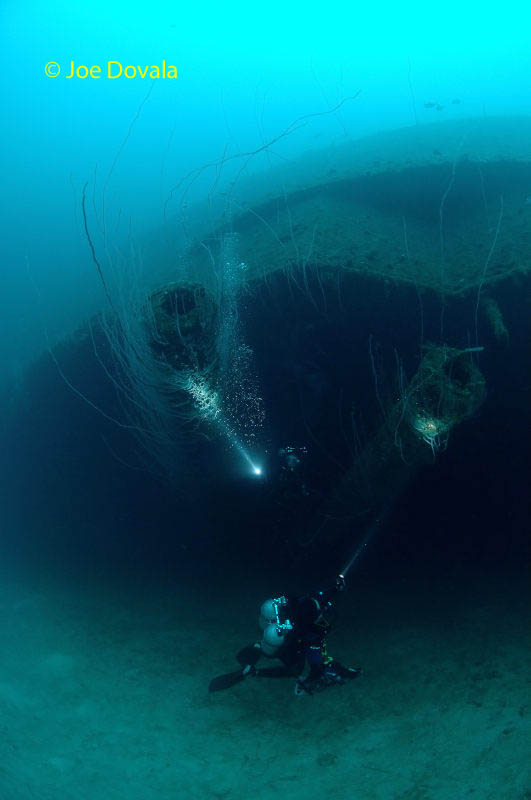
Scuba divers explore the 12 inch main guns on shipwreck USS Arkansas, Bikini Atoll, Marshall Islands, Micronesia, Pacific
On July 3, 1946 and again on July 25, two nuclear bombs known as Able and Baker (about the size of those dropped over Japan) were detonated over and in the lagoon. Able was an air blast dropped from a B-29 and Baker was an underwater eruption which produced the most famous nuclear explosion film/photograph of all time. No matter how many times I see it I just sit slack jawed in awe. On a side note, soon after the initial tests two Frenchmen by the names of Heim and Reard are credited with designing a new two-piece bathing suit which became known as “The Bikini.” It took a while but the style became very popular in the mid 50’s and it was proclaimed that this “swim” suit was going to have the same affect on the male libido as the bombs had on Bikini Atoll. I would tend to agree….Let’s see, where was I…
Oh yes, amazingly only 14 of the ships sank directly but those that were still afloat had become so contaminated that they had to be scuttled over the next few days to months. It was during this process that hundreds of American soldiers and sailors were exposed to exceedingly high radioactivity and many paid the price in long-term health effects. Our ignorance of nuclear fission at the time of these tests was staggering. For a very sobering account of this see the film Radio Bikini (1987).
The Japanese did not fortify Bikini Atoll so it escaped almost unscathed from the horrors of the Pacific campaign. The roughly 160 endemic inhabitants lived a simple and healthy life far from the travails of modern society. Being a peaceful people and nomadic in origin, it didn’t take a Johnny Cochran to convince them that they needed to go to another island “for a little while,” while the United States showed the rest of the world what harnessing the atom was all about. They were told that they could return in less than a year. It didn’t quite work out that way and their principal residence island is now Kili and Majuro. As with most displacement of an indigenous people their culture was irrevocably destroyed and must be added to the “casualty list” of Operation Crossroads. Able and Baker were just two of twenty-three nuclear weapons detonated in the lagoon. The first hydrogen bomb ever set off (Bravo 1954) was the most damaging and enduring explosion. This blast was far bigger and deposited more radioactive fallout then any of the earlier tests and was highly underestimated. Several islets in the atoll were vaporized and many people on distant islands, as well as a Japanese fishing boat, were smothered in ash. A number got sick and more than a few deaths were attributed to Bravo.
Looking at the island of Bikini now you would never suspect such a malevolent history. It’s an absolutely gorgeous coconut palm studded landscape with miles of deserted pink and white sand beaches. The background radiation in the lagoon and on the sunken ships is less than what we received from our long plane flights from California. The lush coconut palms however have a problem; large amounts of Cesium 137 have been found in the plant life and the coconuts have a slight glow at night. Well, not really, but the magnification effect makes them less than ideal for long-term consumption. Unfortunately, Cesium 137 is mistaken for potassium by plants and is concentrated within the plant’s tissue. So unless you are going to grow hydroponicaly, food plants would continue to take in cesium from the soil and pass it up the food chain – sound familiar? Attempts have been made at clean up but with only limited success. The number of half-lives required to make this brand of cesium “safe” will take many more years. All food and produce have to be brought in by supply ship or air. The fresh water is produced from desalinization. Visiting Bikini requires the usual satchel of waivers and disclaimers plus a good read of the latest radiological report.
The sunken ships read like a who’s who lineup from naval history. An aircraft carrier, battleships, a cruiser, destroyers, several aircraft, and two submarines, lie on the bottom of the lagoon all within range of advanced sport divers. One of the most provocative ships is the HIJMS Nagato. This Japanese battleship was the flagship of Admiral Isoroku Yamamoto, the architect of the attack on Pearl Harbor. You can swim by and touch the bridge where he stood and gave the order “Climb Mount Niitaka” which signaled the raid to begin on December 7, 1941. As with most battleships, she lies upside down because these dreadnoughts are very top heavy from the massive armor topside and almost always turn turtle when they sink. Even though the Nagato sits on her decks it is a most impressive site from the four giant props to the massive sixteen-inch guns pointing toward the sand. To quote historical country singer Johnny Horton “….with guns as big as steers and the shells as big as trees…” They’re really, really BIG.
While Johnny was singing about the German battleship Bismark, any gun that can hurl a two thousand pound shell over twenty miles would qualify for these lyrics. The Nagato was the last surviving large capital ship of the Japanese Imperial Navy and considering its role in starting the Pacific war, it is no surprise that she ended up in Crossroads – with considerable effort by a combined American/Japanese crew – as nuclear fodder. The USS Arkansas is the American battleship in the Bikini lineup and she’s one of the oldest. Her career started before WWI in 1912. She was in the Atlantic on December 7, 1941, engaged in convoy duty. She participated in both theaters of WWII by providing support at the Normandy invasion and then saw action in the Pacific at Iwo Jima and Okinawa. Considerably smaller then the Nagato, she represents old world dreadnaught technology and although she too lies upside down her very distinctive sickle shaped hull is a dramatic sight.
The two American destroyers, Anderson and Lamson, are small enough to take in the whole ship on a single dive. Make no mistake though; these highly decorated veterans (15 battle stars combined) saw action throughout the war. Anderson laying on her port side and Lamson settled upright make fantastic dives with scores of interesting sights to eat up the twenty-five minute bottom times allowed on most dives. Looking at the relative size of these escort ships, you realize the special breed of sailor it must have taken to keep these “tin cans” in close proximity to the large fast aircraft carriers moving in mountainous open ocean waves. The American fleet submarine Apogon also sits upright and looks very much intact. If you visit the USS Bowfin in Pearl Harbor you can get a good take on what life was like below the waves during WWII. A hole has opened up in Apogon’s pressure hull and if you stick your head in you can view inside the forward torpedo room. After seeing the long ago flooded compartment it is easy to imagine the dozens of U.S. subs that never returned lying in their lonely undersea graveyards. Located next to the Bowfin, in Pearl Harbor, is a submarine memorial listing all the boats that didn’t come back. Each of the many plaques gives a brief story on the sub and lists the names of the sailors lost. As you might expect most of the vessels were lost with all hands somewhere in the Pacific. The closing epitaph on each one is “On Eternal Patrol.” As we are reminded periodically, the price of liberty is indeed high.
There are primarily nine ships and one submarine that make up the weeks dive itinerary. Depending on the group there is some leeway on how to dive them. Most dives are beyond recreational limits (avg depth 150-165ft with up to 45min of deco) but the warm clear water without appreciable currents makes for a nearly narcosis free excursion. These ships went down fully armed and fueled. Live ammunition is everywhere and leaking oil can be encountered. There are cables, debris, silt, and more than a fair share of obstacles to watch out for. However, good buoyancy skills and the ability to follow a dive plan is 95% of a diver’s requirement. This destination is not easy to get to, nor is it for someone who wants “night life;” it’s currently only available by the occasional liveaboard. But if stretching your eyes out on a beautiful uninhabited atoll and blowing bubbles over and in some of the finest historical wrecks in the world sounds appealing, then Bikini should be high on the list.
Words & Photos by Joe Dovala, Dovala Photography. Visit Joe’s website here.
Photo Gallery (Click to enlarge):
- The Wheel of the Nagato
- Scuba divers explore the 12 inch main guns on shipwreck USS Arkansas, Bikini Atoll, Marshall Islands, Micronesia, Pacific
- American submarine USS Apogon, Bikini Atoll
- Sunset looking from galley at dinner time, Bikini Atoll, Marshall Islands, Micronesia, Pacific
- Snorkler at Aomen Island in Bikini Atoll
- Radioactive coconuts with Ce_135_MR
- Diver pulls tea pot from silt inside USS Saratoga.
- A U.S. Navy Mark V diving helmet on the USS Saratoga at Bikini Atoll
- Main 16 inch guns of the HIJMS Nagato Bikini Atoll
- Bicycle with car steering wheel attached, mutated bicycle
- One of four huge propellors on HIJMS Nagato at Bikini Atoll
- Landing craft used as diving platform
- Jungle tour, Bikini Atoll, Marshall Islands, Micronesia, Pacific
- Navy Hell Diver fighter in the hanger deck of the USS Saratoga at Bikini Atoll
- A bunker on Aomen Island used during H-bomb tests at Bikini Atoll
- Trash can overlooks area where nuclear testing took place
- Dive briefing selecting entry points for penetration on USS Saratoga
- Scuba divers congregate around island on ship wreck USS Saratoga, Bikini Atoll
- Evening clouds over lagoon
- Not fancy but comfortable rooms for divers.
- Scuba diver swims inside HIJMS Nagato.
- A scuba diver comes up to live depth charges at depth on ship wreck USS Lamson, Bikini Atoll.
- Scuba diver examines safe in dentist office on ship wreck USS Saratoga
- Coral head with snorkler in background
- Scuba divers coming in for landing on deck of USS Saratoga
- Scuba diver examines radar screen in CIC on ship wreck USS Saratoga
- Scuba diver on bridge of the ship wreck HIJMS Nagato
- Bridge gauges on USS Saratoga
- Corrugated hull of USS Arkansas caused from Baker explosion
- Three inch stern gun of USS Apogon
- Scuba diver near bow of ship wreck USS Anderson
- Air field on Eneu, Bikini Atoll
- Aft open hatch on USS Anderson
- Still live 1000 pound bomb strapped down in ship wreck USS Saratoga
- Scuba diver looks at live 5 inch shells on submarine wreck USS Apogon, Bikini Atoll
- Five mile beach on lagoon side is nearly always empty

